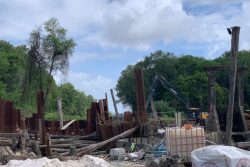The Amaila Falls Hydroelectric project is expected to have a transformational impact on the Guyanese economy, but also poses large fiscal risks should it fail to deliver the promised benefits, a recently released International Monetary Fund (IMF) report has warned.
The Staff Representatives for the 2010 Consultation with Guyana, in their report, said that “the impact of the Amaila Falls project will need to be carefully monitored, during the construction (end-2011–14) as well as at the operational stages (2015 onward) to ensure that the economic benefits materialize as expected, especially on energy costs and the Guyana Power and Light Company’s (GPL) balance sheet.” The fiscal risks associated with the public-private partnership need to be monitored carefully, the report said.

According to the report, the staff welcomed the level of transparency and public disclosure of the project to date, including reflecting any firm or contingent liabilities from Purchasing Power Parity (PPP)s in debt statistics, and encouraged the authorities to continue in this vein. The report was dated January, 2011.
“Guyana’s PPPs will require close attention to international best practices. Moreover, should the projected surge in solvent demand fail to materialize, there is a risk that GPL’s finances could be adversely affected,” the report added.
During construction, the project is likely to add cumulatively 6 percentage points of real Gross Domestic Product (GDP) growth, the report stated. “Further economic gains, once the project is completed, would depend on the adopted tariff structure and the impact of this on total factor productivity and capital accumulation and its quality,” the report said.
It added that based on current information, it is expected that the hydropower project would eventually result in a 20 to 40 percent reduction in the cost of generation as the switch from oil to hydro takes place. “The precise extent of the pass-through of these savings to the end-user would depend on the PPA and its impact on GPL’s operational balance,” the report said.
The report noted too that “imports are expected to increase between 2012 and 2014 as the Foreign Direct Investment (FDI) flows are used to purchase materials and equipment, widening the external current account deficit to some 16-18 percent of GDP.” Once completed, the project is likely to result in a 20 to 25 [percent] reduction in fuel imports, as the GPL switches to sourcing its power needs from the Amaila hydropower. A key issue, the report said, is the extent of the displacement that the hydropower can provide “as GPL would need to maintain backup generation capacity, which increases with the size of its market, as private self generators purchase cheaper electricity from GPL and stop self- generating.”
The report said that the impact on public finances during the construction stage of the project should be minimal since the government will not participate in the construction process. It is expected that the private contractor will assume any cost overruns. “In the event, however, that the government assumes the full obligations of the project, public debt to GDP ratio would rise by 30 percentage points,” the report said. In the event that this happens, the private contractor would forsake its obligations and its debt is assumed by the government; a fraction of the annual payment made previously to the private contractor will now be used to service the debt.
“In the baseline scenario, where electricity tariffs are unchanged, GPL’s overall balance is projected to show a surplus of about 0.5 percent of GDP in 2015,” the report said. 2015 is the year the Amaila Falls is scheduled to start operating. However, in the alternative scenario, “with a tariff reduction of 20 percent offset by an increase in electricity consumption, GPL’s overall balance (surplus) falls marginally to 0.4 percent of GDP,” the report said. “Revenues would remain unchanged (unitary elasticity), and GPL’s first payment to the private operator would be a bit higher than the cost of materials and supplies (largely oil imports) in the baseline scenario,” the report added.
The Amaila Falls hydropower plant is a 165MW facility proposed to be constructed immediately upstream from the confluence of the Amaila and Kuribrong rivers. GPL is supposed to purchase the project’s entire output of approximately 143 MW of delivered capacity under a 20-year Power Purchase Agreement.
Construction of the plant is expected to commence before the end of the year though the project has been hit by numerous delays. The final cost of constructing the plant is likely to be known by next month, which would then pave the way for financial closure for the project to be secured.





